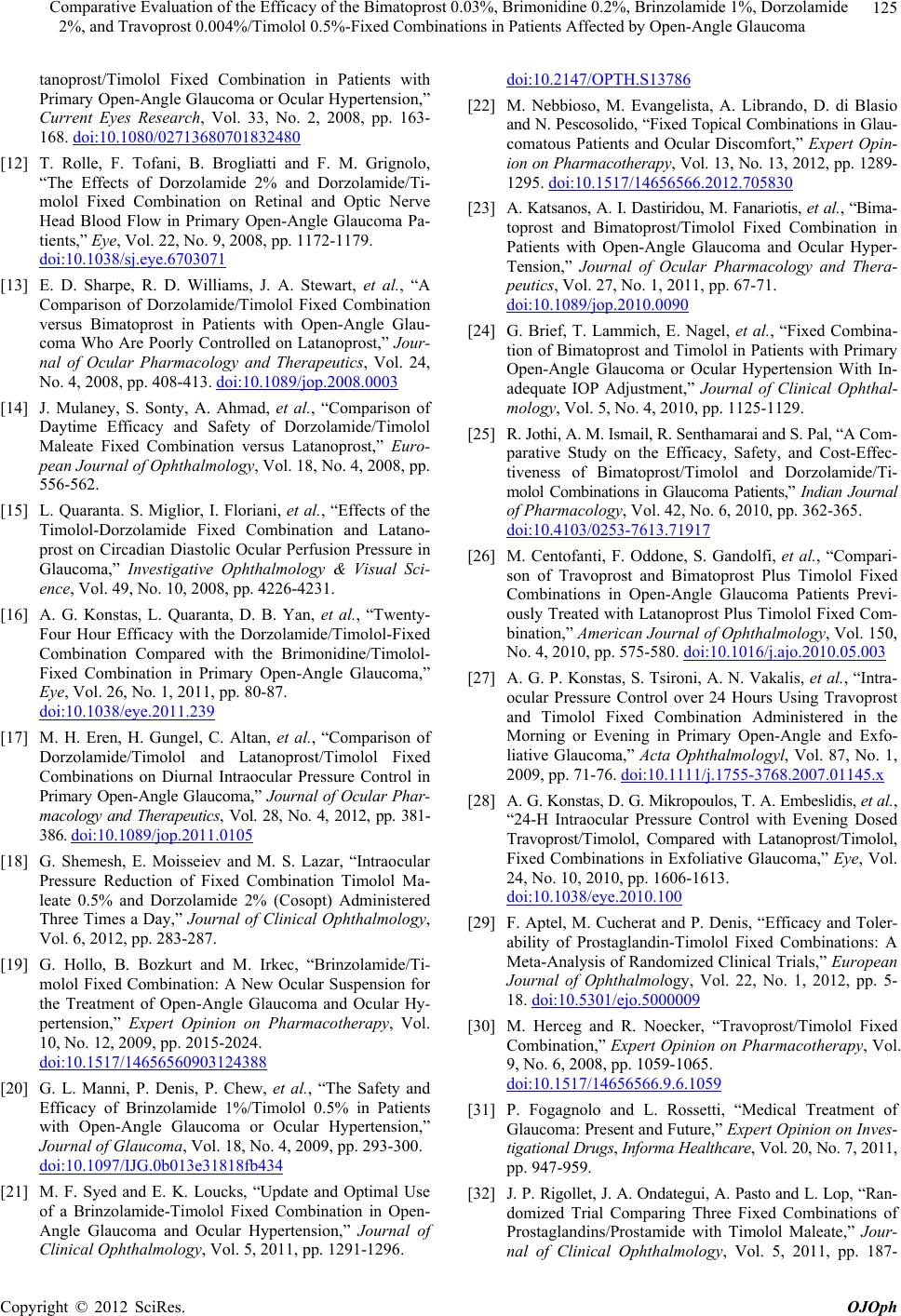
Comparative Evaluation of the Efficacy of the Bimatoprost 0.03%, Brimonidine 0.2%, Brinzolamide 1%, Dorzolamide
2%, and Travoprost 0.004%/Timolol 0.5%-Fixed Combinations in Patients Affected by Open-Angle Glaucoma
125
tanoprost/Timolol Fixed Combination in Patients with
Primary Open-Angle Glaucoma or Ocular Hypertension,”
Current Eyes Research, Vol. 33, No. 2, 2008, pp. 163-
168. doi:10.1080/02713680701832480
[12] T. Rolle, F. Tofani, B. Brogliatti and F. M. Grignolo,
“The Effects of Dorzolamide 2% and Dorzolamide/Ti-
molol Fixed Combination on Retinal and Optic Nerve
Head Blood Flow in Primary Open-Angle Glaucoma Pa-
tients,” Eye, Vol. 22, No. 9, 2008, pp. 1172-1179.
doi:10.1038/sj.eye.6703071
[13] E. D. Sharpe, R. D. Williams, J. A. Stewart, et al., “A
Comparison of Dorzolamide/Timolol Fixed Combination
versus Bimatoprost in Patients with Open-Angle Glau-
coma Who Are Poorly Controlled on Latanoprost,” Jour-
nal of Ocular Pharmacology and Therapeutics, Vol. 24,
No. 4, 2008, pp. 408-413. doi:10.1089/jop.2008.0003
[14] J. Mulaney, S. Sonty, A. Ahmad, et al., “Comparison of
Daytime Efficacy and Safety of Dorzolamide/Timolol
Maleate Fixed Combination versus Latanoprost,” Euro-
pean Journal of Ophthalmology, Vol. 18, No. 4, 2008, pp.
556-562.
[15] L. Quaranta. S. Miglior, I. Floriani, et al., “Effects of the
Timolol-Dorzolamide Fixed Combination and Latano-
prost on Circadian Diastolic Ocular Perfusion Pressure in
Glaucoma,” Investigative Ophthalmology & Visual Sci-
ence, Vol. 49, No. 10, 2008, pp. 4226-4231.
[16] A. G. Konstas, L. Quaranta, D. B. Yan, et al., “Twenty-
Four Hour Efficacy with the Dorzolamide/Timolol-Fixed
Combination Compared with the Brimonidine/Timolol-
Fixed Combination in Primary Open-Angle Glaucoma,”
Eye, Vol. 26, No. 1, 2011, pp. 80-87.
doi:10.1038/eye.2011.239
[17] M. H. Eren, H. Gungel, C. Altan, et al., “Comparison of
Dorzolamide/Timolol and Latanoprost/Timolol Fixed
Combinations on Diurnal Intraocular Pressure Control in
Primary Open-Angle Glaucoma,” Journal of Ocular Phar-
macology and Therapeutics, Vol. 28, No. 4, 2012, pp. 381-
386. doi:10.1089/jop.2011.0105
[18] G. Shemesh, E. Moisseiev and M. S. Lazar, “Intraocular
Pressure Reduction of Fixed Combination Timolol Ma-
leate 0.5% and Dorzolamide 2% (Cosopt) Administered
Three Times a Day,” Journal of Clinical Ophthalmology,
Vol. 6, 2012, pp. 283-287.
[19] G. Hollo, B. Bozkurt and M. Irkec, “Brinzolamide/Ti-
molol Fixed Combination: A New Ocular Suspension for
the Treatment of Open-Angle Glaucoma and Ocular Hy-
pertension,” Expert Opinion on Pharmacotherapy, Vol.
10, No. 12, 2009, pp. 2015-2024.
doi:10.1517/14656560903124388
[20] G. L. Manni, P. Denis, P. Chew, et al., “The Safety and
Efficacy of Brinzolamide 1%/Timolol 0.5% in Patients
with Open-Angle Glaucoma or Ocular Hypertension,”
Journal of Glaucoma, Vol. 18, No. 4, 2009, pp. 293-300.
doi:10.1097/IJG.0b013e31818fb434
[21] M. F. Syed and E. K. Loucks, “Update and Optimal Use
of a Brinzolamide-Timolol Fixed Combination in Open-
Angle Glaucoma and Ocular Hypertension,” Journal of
Clinical Ophthalmology, Vol. 5, 2011, pp. 1291-1296.
doi:10.2147/OPTH.S13786
[22] M. Nebbioso, M. Evangelista, A. Librando, D. di Blasio
and N. Pescosolido, “Fixed Topical Combinations in Glau-
comatous Patients and Ocular Discomfort,” Expert Opin-
ion on Pharmacotherapy, Vol. 13, No. 13, 2012, pp. 1289-
1295. doi:10.1517/14656566.2012.705830
[23] A. Katsanos, A. I. Dastiridou, M. Fanariotis, et al., “Bima-
toprost and Bimatoprost/Timolol Fixed Combination in
Patients with Open-Angle Glaucoma and Ocular Hyper-
Tension,” Journal of Ocular Pharmacology and Thera-
peutics, Vol. 27, No. 1, 2011, pp. 67-71.
doi:10.1089/jop.2010.0090
[24] G. Brief, T. Lammich, E. Nagel, et al., “Fixed Combina-
tion of Bimatoprost and Timolol in Patients with Primary
Open-Angle Glaucoma or Ocular Hypertension With In-
adequate IOP Adjustment,” Journal of Clinical Ophthal-
mology, Vol. 5, No. 4, 2010, pp. 1125-1129.
[25] R. Jothi, A. M. Ismail, R. Senthamarai and S. Pal, “A Com-
parative Study on the Efficacy, Safety, and Cost-Effec-
tiveness of Bimatoprost/Timolol and Dorzolamide/Ti-
molol Combinations in Glaucoma Patients,” Indian Journal
of Pharmacology, Vol. 42, No. 6, 2010, pp. 362-365.
doi:10.4103/0253-7613.71917
[26] M. Centofanti, F. Oddone, S. Gandolfi, et al., “Compari-
son of Travoprost and Bimatoprost Plus Timolol Fixed
Combinations in Open-Angle Glaucoma Patients Previ-
ously Treated with Latanoprost Plus Timolol Fixed Com-
bination,” American Journal of Ophthalmology, Vol. 150,
No. 4, 2010, pp. 575-580. doi:10.1016/j.ajo.2010.05.003
[27] A. G. P. Konstas, S. Tsironi, A. N. Vakalis, et al., “Intra-
ocular Pressure Control over 24 Hours Using Travoprost
and Timolol Fixed Combination Administered in the
Morning or Evening in Primary Open-Angle and Exfo-
liative Glaucoma,” Acta Ophthalmologyl, Vol. 87, No. 1,
2009, pp. 71-76. doi:10.1111/j.1755-3768.2007.01145.x
[28] A. G. Konstas, D. G. Mikropoulos, T. A. Embeslidis, et al.,
“24-H Intraocular Pressure Control with Evening Dosed
Travoprost/Timolol, Compared with Latanoprost/Timolol,
Fixed Combinations in Exfoliative Glaucoma,” Eye, Vol.
24, No. 10, 2010, pp. 1606-1613.
doi:10.1038/eye.2010.100
[29] F. Aptel, M. Cucherat and P. Denis, “Efficacy and Toler-
ability of Prostaglandin-Timolol Fixed Combinations: A
Meta-Analysis of Randomized Clinical Trials,” European
Journal of Ophthalmology, Vol. 22, No. 1, 2012, pp. 5-
18. doi:10.5301/ejo.5000009
[30] M. Herceg and R. Noecker, “Travoprost/Timolol Fixed
Combination,” Expert Opinion on Pharmacotherapy, Vol.
9, No. 6, 2008, pp. 1059-1065.
doi:10.1517/14656566.9.6.1059
[31] P. Fogagnolo and L. Rossetti, “Medical Treatment of
Glaucoma: Present and Future,” Expert Opinion on Inves-
tigational Drugs, Informa Healthcare, Vol. 20, No. 7, 2011,
pp. 947-959.
[32] J. P. Rigollet, J. A. Ondategui, A. Pasto and L. Lop, “Ran-
domized Trial Comparing Three Fixed Combinations of
Prostaglandins/Prostamide with Timolol Maleate,” Jour-
nal of Clinical Ophthalmology, Vol. 5, 2011, pp. 187-
Copyright © 2012 SciRes. OJOph